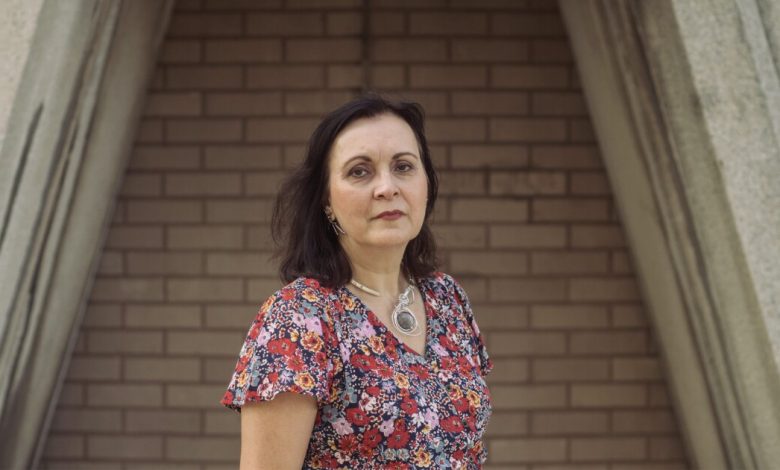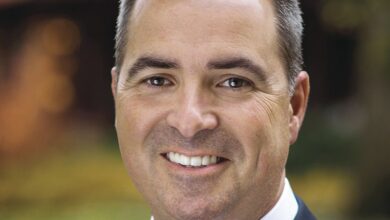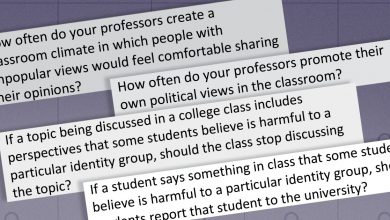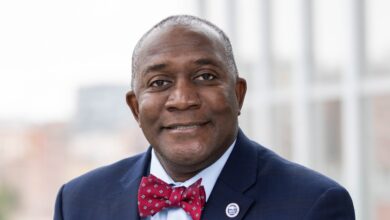This University Laid Off Dozens of Professors. The Pain Didn’t End There.

[ad_1]
In the early months of the pandemic, the Ohio university laid off close to 100 faculty members, including Bilia. But the service Bilia had provided to the university — teaching “the bread and butter courses” of the English department for over 15 years — was still needed. So the university hired her back as an adjunct.
“For people like me,” she said, “it was like an assassination of our careers.”
For people like me, it was like an assassination of our careers.
Before the layoffs, Akron had been struggling. From 2011 to 2020, undergraduate enrollment dropped nearly 40 percent. “The sky has been falling,” one professor said. Discussion of faculty cuts over time was already underway. When the Covid-19 pandemic struck, in the spring of 2020, everything changed. And layoffs were needed sooner.
When the university announced the cuts, the then president of the faculty union called it a “bloodbath.” Since then, similar cutbacks have followed elsewhere. Henderson State University, in Arkadelphia, Ark., laid off 67 faculty members after it declared a state of financial exigency; Ithaca College, in upstate New York, cut the full-time equivalent of 116 faculty positions.
Akron’s leaders say the layoffs were necessary to protect the institution. Faculty members and the provost say steps have been taken to improve relations with the administration. Provost John Wiencek said in an interview that faculty and staff members had been “indeed hurt significantly” by the layoffs. But Akron was not alone, he said. Other colleges “just didn’t get the kind of coverage that the University of Akron did,” he said. “Because we made a decision immediately, and we moved on.”
But for the 96 faculty members who were part of the “reduction in force,” moving on has been nearly impossible. They call themselves “the RIF,” pronounced like “riff.” They see themselves as the human toll in a nightmare version of higher ed’s future, plagued by declining enrollments, cuts in state funding, assaults on tenure, and a bottom-line mentality more suited to a business.
Finding a new academic job has proved difficult, and they don’t want to uproot their families. Thirty-six have, like Bilia, returned to work at Akron as adjuncts — doing similar jobs for less pay. The laid-off professors want their colleagues elsewhere to know that nothing can stop the cuts once they begin. Not tenure, a union, teaching awards, or praise from students.
Revenues from tuition, fees, and services were down, the president said. Funding from the state had been slashed. In the months after the pandemic began, the public university projected a 2021 budget deficit of $65 million.
President Gary L. Miller said faculty, staff, and students had “admirably weathered the first shocks of this pandemic and kept the university operating.” Now, Miller said, they had to look ahead, which would require Akron “to act immediately and with bold confidence to deploy a new design for this university.”
The “new design” meant consolidating the university’s 11 schools into five, to combine units that had “synergy,” Wiencek, the provost, told The Chronicle. And it meant reducing the number of employees.
On May 19, 2020, the faculty union learned about the planned layoffs through a “Catastrophic Circumstances Letter” from Akron’s administration.
The university was invoking the force majeure clause of its contract with the union, the Akron chapter of the American Association of University Professors. The clause, which a catastrophic event like a pandemic can bring into play, allowed the university to take drastic steps while bypassing standard procedures.
The university and union had been in talks before the pandemic to reduce the faculty-student ratio, Wiencek said, but the process would have spread over time and involved retirements and departures, not layoffs.

Andrew Spear for The Chronicle
“Unfortunately, the pandemic required us to move more quickly on that,” Wiencek said.
On July 15, 2020, Akron’s Board of Trustees unanimously approved 178 layoffs.
The faculty union then filed two grievances on behalf of the laid-off professors. One, which went to arbitration, argued that the university had not demonstrated how the pandemic justified the use of the force majeure clause, and that the clause did not excuse the university from following other agreed-upon procedures for layoffs. The union eventually lost in arbitration.
The second grievance alleged that the university had targeted particular faculty members for layoffs. According to data compiled by the union, faculty members on the “RIF” list were more likely to be associated with the union than were faculty members over all. Forty-four faculty members had filed serious complaints involving the university, such as a grievance. Thirty-four of them were laid off.
In a separate analysis, Sue Ramlo, a tenured professor who lost her job, showed that women and professors of color were laid off at a disproportionate rate.
In a written statement, an Akron spokeswoman acknowledged that both the faculty union and some of those laid off had alleged discrimination. But none of the claims had succeeded so far, she wrote, citing recent decisions by the Ohio Civil Rights Commission that the university’s actions had complied with the law.
The union, meanwhile, decided to scale back its approach, instead of fighting what its leaders feared would be losing battles. Each person laid off had been chosen at the department level, not by Akron’s provost, making it harder to argue the layoffs had been targeted, said Pamela Schulze, a professor and director of the Center for Family Studies, who was the union chapter’s president when the layoffs occurred.
A lawyer who has represented faculty members in union disputes for 30 years agreed with that view. When layoffs are decided at the department level, it can be difficult to prove that any disparate impacts were intentional, said Beth Margolis, a partner at the law firm of Gladstein, Reif & Meginniss. “It’s quite possible that you might not have a very strong case for all of those people,” she said.
So Akron’s union focused on the professors with the most compelling arguments for getting their jobs back, Schulze said. “In my gut, I just wanted to fight every single one of them,” she said. “What happened was so gut-wrenching. It was so hard. It was like watching people fall off a cliff.”
Of the 96 selected for the “RIF,” 23 filed individual grievances. Only two professors eventually had their cases brought to arbitration by the union.
She had been telling people for years that becoming a tenured professor was a “pipe dream.” By the time Bilia had finished getting her Ph.D. in English, she said, “it was crystal-clear that there are these different classes of academic workers.”
Tenured professors were at the top; adjuncts were at the bottom. She would tell others to never stick around at a university as an adjunct: “If you cannot find a job within five years, get the hell out because you will be unemployable.”
Bilia moved to Kent State University, in Ohio, from Greece in 1985. She met her husband there while attending grad school. She later spent time as an adjunct at other colleges before becoming an administrative-support assistant at Duke University, where she wrote promotional material. As a 38-year-old Ph.D., she was making a check every two weeks with four digits for the first time in her career.
In 2003 her husband got a tenured position as a library-science professor at Akron, so they moved back to Ohio. In the back of her mind, Bilia wanted to return to teaching. “You kind of feel guilty,” she said. “I got a goddamn Ph.D. You know? I was really good as a teacher.”
You kind of feel guilty. I got a goddamn Ph.D. You know? I was really good as a teacher.
Akron had an opening for a full-time, non-tenure-track professor of instruction. It would be a significant pay cut for her. But the position “was primarily teaching,” Bilia said, “so I embraced it.”
From then on, Bilia taught four courses a semester. She taught in the fall, spring, and summer. She taught basic English composition, world literature, and introductory courses in critical theory. She volunteered at the university and in the union. She presented at academic conferences. She had experience teaching online and hybrid courses.
It wasn’t enough to prevent her from landing on the layoff list — with her husband.
To get by, they withdrew money from her husband’s retirement account and relied on unemployment benefits. Bilia soon returned to the university to work part time. Their youngest son, then in high school, started a job at Walmart. Last year, she said, he made more money than she did.
“The administrators do not know what our families have gone through,” Bilia said, “how our kids are looking into a future that’s bleak.”
Some nights, she said, she would find her youngest son up late pacing, worried about the family and the future. She tried to tell him he was young and had his whole future ahead of him. But he reminded her of what had happened to them, and how things could change in an instant. “What answers do I have for that?” she asked.
Bilia has applied to dozens of jobs elsewhere. While she looks, she’s still teaching as an adjunct at Akron. She’s done the math: She once was paid more than double what she earns now for each course, while also being able to teach an additional class.
Under the union’s contract with the university, laid-off faculty members have first dibs on part-time jobs at Akron if they are reasonably qualified for them.
Wiencek, the provost, denied that the university had set out to replace tenured professors with part-time faculty members. Faculty positions are “all down proportionately,” he said. “So it’s not as if we dramatically increased the number of adjuncts and decreased the number of full-time employees.” University data largely back him up: The number of full-time faculty members has dropped, but the number of part-timers has stayed relatively flat.
Huey-li Li is among the tenured professors who have turned into adjuncts.
“I don’t see myself as a victim … I see the University of Akron as the victim,” said Li, who works in the education department. Many of her students, Li said, came from working-class backgrounds. The layoffs, she said, felt like an abandonment of Akron’s mission to serve them. Administrators, she said, “don’t believe in humanity.”
Li said it would be easier to walk away, but what happened is not right. She sued the university, alleging she had been discriminated against as an Asian woman. Her complaint says that 24 percent of those laid off were of Asian descent. In a recent court filing, the university denied those claims.
“But there’s no acknowledgment of the hell I’ve been through,” she said. Those who remained wanted to pretend things were OK, she said.
“There’s a lot of things that … the survivors don’t accept because it’s too ugly,” Ramlo said. “They don’t want to accept how awful this was. How treacherous it was for everybody in the ‘RIF.’ How career-ending and traumatic. I mean, I really think that a lot of us have PTSD from the experience.”
Back in 2020, the same day Akron’s board voted to approve the layoffs, Ramlo got an email, titled “Individual Meeting,” from the top administrator in her department — a new unit that she had just joined as part of the university’s reorganization. The email asked if she could join a call to talk about the university’s “financial and budget-related matters.”

Marvin Fong for The Chronicle
Ramlo knew layoffs were coming. She served in the Faculty Senate and was vice president of the union. But she never knew who was on the list. As soon as she saw the email, she knew she was gone. The call, she said, lasted maybe five minutes.
She was given no reason for her layoff, other than that it was for financial reasons. At that moment, Ramlo said, she felt she had been targeted. Tenured and with more than 15 years at the university, Ramlo had long felt that she had an obligation to speak up about issues on campus. Graduate students, adjuncts, and even faculty members with tenure, she said, would voice their concerns to her.
“I was always the brave one — all five feet of me,” she said.
Other laid-off faculty members also said they had been let go over their affiliation with the union, outspokenness on issues on campus, and complaints against the university.
Throughout the summer of 2020, the faculty union pressed the university to disclose why people had been chosen for the “RIF.” Once Ramlo saw the university’s rationale, she and the union started to poke holes in it.
In June of this year, after going through the arbitration process, she won her job back.
While it had not been proven that the university had targeted Ramlo due to an “anti-union animus,” the arbitrator said, the union had successfully argued that the decision to lay her off “was based on shifting and sometimes contradictory grounds.”
Akron, the arbitrator wrote, had relied on an “inaccurate set of facts, and the university, when confronted with those discrepancies, failed to take any steps to address or correct those discrepancies.”
This fall, Ramlo will return to the classroom once again, as a full-time professor of general technology. She will receive back pay for the two years she lost — an amount still under negotiation. Another faculty member, the dance professor Robin Prichard, will also be back after winning her arbitration. The university attempted to hire for two full-time positions similar to her previous post without first offering them to her, as the contract requires.
The university and the union have agreed to both a new contract and a memorandum of understanding that provide a framework to work together, Wiencek said. The university has been more transparent about its budget with the union and Faculty Senate, he added, and is working with faculty leaders on hiring and planning.
For some, the layoffs have actually helped. Linda Orr, a former associate professor of marketing, “was seriously in utter shock” when she learned she was on the “RIF” list. She now owns her own marketing-consulting company. She works fewer hours than she did as a professor, and makes far more money, Orr said.
“It was such a toxic workplace, like toxic doesn’t even begin to describe how bad it was,” Orr said. “And I guess after the shock wore off, and I kind of was probably depressed for about a week, then I found myself being happier than I had ever been before in my life. And I have been for the past two years.”
Those still at Akron are surviving. They go to work and try to do their best for the students.
Toni L. Bisconti, an associate professor of psychology and the union’s current president, said the impact of the layoffs had been twofold for those who remain. Their workload has, of course, increased.
The other outcome “is a lack of trust and feeling demoralized and burnt out and just having that overarching feeling of dread,” Bisconti said. “People were miserable. The culture had become super-negative. I think we felt just completely taken advantage of. I think we were demoralized. I think we all felt that we could have been on that list.”
For Schulze, the former union president, guiding the chapter through the layoffs was one of the hardest experiences of her life. It’s a challenge as well, she said, to continue working for Akron, knowing what it did to her colleagues.
Some professors may blame her and the union for what happened, Schulze said, and she doesn’t blame them. She accepts what happened “as a reality that we have to live with.” But to this day, she said, she believes what happened at Akron was wrong.
For those laid off, the impact of the “RIF” persists.
This fall, Bilia will return to Akron for a fourth semester as an adjunct. She’s still looking for other work.
On a recent morning, she checked online to see if the local Target was hiring.
[ad_2]
Source link






